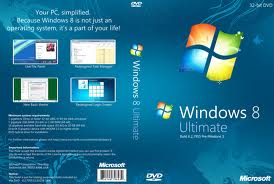|
| |
New features: Windows 8
Main
Article page |
Beauty articles
|
Health page |
Computers|
Diseases |
Education |
Entertainment |
Family
Business |Fitness|
Fruits and Vegetables
|
Jobs |
General |
Personality|
Technology
|
Tourism |
Useful Tips
Biography Page|
Heroes & Incredible peoples
|
Inventions
Computer Main page|
Free weekly downloads|
Twitter |
Printer drivers|
Antivirus |
Children safety |
SMS|
Articles

Windows 8 is the current release of the Windows
operating system, produced by Microsoft for use on personal computers, including
home and business desktops, laptops, tablets, and home theater PCs. It was
officially released on 26th October 2012. The operating system was released to
manufacturing on August 1, 2012, and was released for general availability on
October 26, 2012.
Windows 8 introduces significant changes to the operating system's platform,
primarily focused towards improving its experience on mobile devices such as
tablets to rival other mobile operating systems such as Android and iOS, taking
advantage of new and emerging technologies (such as USB 3.0, UEFI,cloud
computing, and the low-power ARM architecture), new security features (such as
malware filtering, built-in antivirus software, along with other changes and
performance improvements.
Windows 8 also introduces a new shell and user
interface based off Microsoft's "Metro" design language, featuring a new Start
screen with a grid of dynamically updating tiles to represent applications
Q:What editions are available
for Windows 8?
A: There
are four editions as noted below. These are discussed in the Announcing
the Windows 8 Editions post on
the
Blogging Windows blog and theIntroducing
Windows 8 Enterprise and Enhanced Software Assurance for Today’s Modern
Workforce post on theWindows
for your Business blog.
-
Windows 8: For consumers
-
Windows 8 Pro: For business and technical professionals
-
Windows 8 Enterprise: For enterprise customers with software
assurance
-
Windows 8 RT: For supporting ARM devices
Q: How
do I upgrade from Windows 8 Consumer Preview (CP) or Windows 8 Release Preview
(RP) to the Released-to-Manufacturing (RTM) version of Windows 8?
A: There is
no upgrade path from Windows 8 Consumer Preview or Windows 8 Release Preview to
the Released-to-Manufacturing (RTM) version of Windows 8. If you have already
installed Windows 8 Consumer Preview or Windows 8 Release Preview, you will be
required to perform a clean install. The installation process will automatically
create a Windows.old folder that contains all files from your Windows 8 Consumer
Preview or Windows 8 Release Preview installation.
Q: How
do I delete the Windows.old folder?
A: To delete
the Windows.old folder, you follow the same procedure in Windows 8 as you do for
Windows 7. Information about deleting the Windows.old folder can be foundhere.
Q: How
can I evaluate Windows 8?
A: You
can download and find out more information about the 32-bit or 64-bit 90-day
evaluation of Windows 8 Enterprise editionhere.
Q: What
are the Windows 8 Enterprise minimum system requirements?
A: Your
computer must meet the following minimum requirements:
-
1 gigahertz (GHz) or faster processor
-
1 gigabyte (GB) RAM (32-bit) or 2 GB RAM (64-bit)
-
20 GB available hard disk space
-
1366 × 768 screen resolution
-
Microsoft DirectX 9 graphics device with WDDM driver
-
Internet access (fees may apply)
-
Microsoft account (LiveID) required for some features
-
Some features such as touch and Client Hyper-V may require advanced or
Windows 8 certified hardware
-
The Windows To Go feature requires advanced hardware. To learn more about
USB drives certified for Windows To Go, please visitwww.microsoft.com/WindowsToGo.
Q: Where
do I find the Start button?
A: The
Start button has been replaced by the Start screen. For more information about
the decisions behind this, see Steven Sinofsky’s blog postsEvolving
the Start menu and Designing
the Start screen on theBuilding
Windows 8 blog.
Q: How
do I deploy Windows 8?
A: Information
about deploying Windows 8 can be found onDeliver
and Deploy Windows 8 page.
Q: How
do I sideload an app?
A: Information
about sideloading apps and managing the Windows Store can be foundhere.
Q: How
do I access client Hyper-V?
A: Information
about Hyper-V in Windows 8 can be found in theHyper-V
on Windows 8 Client post on the Michael
Niehaus' Windows and Office deployment ramblings blog.
Q: Where
can I find information about how to download and install Windows 8?
A: Information
about downloading and installing Windows 8 can be found on theSpringboard
Series for Windows 8 on TechNet
site.
Q: Where
can I find additional help if I run into a problem or have a question about
Windows 8?
A: Please
search the Windows
8 TechNet forums for an existing
thread that discusses your issue. If you don’t find one, please create a new
thread and ask your question.
Q: How
do I stay informed about Windows 8?
A: You
can keep up with general technical information and news by following theSpringboard
Series Blog. For technical guidance, tips, and tools, visit theSpringboard
Series for Windows 8 on TechNet. You can opt to receive theSpringboard
Series Insider Newsletter or
follow theSpringboard
Series on Twitter.
( Courtesy :
Anthony_Mann, Microsoft MSFT CSG,
http://social.technet.microsoft.com/ )
More information about windows 8
Articles
| |
|



